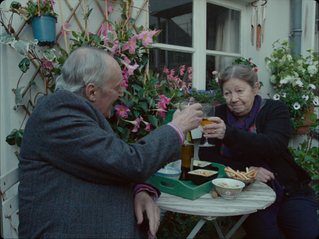The Texas Chain Saw Massacre
- Jessica Moore

- Jun 19, 2020
- 4 min read
Updated: Jan 30, 2022
Tobe Hooper, 1974

In a landscape void of women, masculinity begins to fracture—its definitions loosen. Emasculation is central to the slasher genre’s motivation to chart the abnormal; monsters are constructed as socially deviant, untethered from the status quo. Barbara Creed elaborates on this idea: ‘in the process of being constructed as monstrous, the male is feminized,' that 'this process is not simply a consequence of placing the male in a masochistic position, but rather it stems from the very nature of horror as an encounter with the feminine.’ While this proximal femininity is true of the horror genre as a whole, the slasher sub-genre is, in itself, gender deviant. It would therefore be false to suggest that slasher villains are emasculated simply by way of feminisation; though their emasculation certainly begins with feminisation, the slasher film’s process of emasculation does not stop there—it thwarts the boundaries of gender entirely.
Leatherface (The Texas Chain Saw Massacre) signals the nascence of the prototypic 1970s slasher villain. His arrested development and fervent performativity, teemed with a desire to slaughter multiple victims, signal a shift from the undetectable villainy of his predecessors. By the 1970s, monstrosity became far more legible. Villains were characterised by indeterminate masculinity and transgression, their humanity concealed beneath masks and shapeless physiques. Texas' Leatherface is emasculated by semiotics, covered in baby fat and donning an apron and mask, but equally, he is not feminised. Indeed, Slasher villains do not retreat from one pole of gender to the other; they transmute into that which ruptures gender binaries altogether (hence the significance of Halloween’s Michael amorphously credited ‘The Shape’). Leatherface ‘may be recognisably human, but only marginally so’ summarises peerless horror analyst Carol Clover. It would be far more suitable to describe Leatherface as unsexed or unable to fit into either category of masculine or feminine. As the film progresses, it becomes increasingly clear that the ‘final girl’ (the lone survivor) is not grappling with sexually violent masculinity, but instead repressed inarticulate fury. Even the chainsaw which overtly symbolises phallic violence does not masculinise Leatherface. As the phallic weapon is dismembered, it instead rather strikingly illuminates his sexlessness.
Bending towards orientalist theories of the Other, Leatherface conjures a thoroughly Western impulse; he embodies the dangers of unknowability. Satiated by this opacity, and spurred by a fury against intruders, Leatherface becomes a digressive vehicle through which the horror can manifest, and more importantly, a constant against which the final girl can be constructed.
Within the world of slasher violence, gender is clearly dichotomised. Here, it is worth briefly digressing to state that this essay demands exercising terminology which are now stereotypical, specifically that which constitutes ‘feminine’ and ‘masculine’, because within the framework of the 1970s, and more specifically in the B-movies of the 1970s, gender is conceptualised through archaic definitions. Bizarrely, and rather progressively, the slasher genre sees these gender categories as distinctly unstable. Perhaps this flimsiness is due to the messiness of the genre as low-budget; with a preoccupation to frighten, slashers are reluctant to prioritise any deliberate gender commentary—they are ripe in misogyny, no less. Be that as it may, the instability of their gender categories can yield rather modern interpretations. Indeed, gender is recognised by characters and reified to the advantage of those afforded mobility: the most mobile of all, the final girl.
Coded feminine in a masculine genre, the final girl is located within a space where gender is constantly affirmed. However, because she is not the monstrous villain but the recognisable victim, she does not reject these binaries, she plays with gender to her advantage. As the victim with whom the audience identifies, she is crafted to embody a multitude of recognisable characteristics; she is vehemently maternal, heroic; she is a figure of pragmatism, perceptivity and caution, all of which the villain is entirely void.

Tempted by her fluid crafting, audiences delight in calling the ‘boyish’ final girl a feminist triumph, yet their (justified) veneration begins to simulate the very misogyny they condemn. Of course she out-survived the half-naked girls; her focus was not on boys; she was rational, not frivolous; attuned to the warning signs etc etc. Chiefly, it is a mistake to claim the final girl is not conventionally feminine, because she certainly is. Carol Clover observes ‘where once [the victim] was female, now she is both girl and boy, though most often and most conspicuously girl.’ She is not a ‘shape’, deviated from gender like her villain. She is the normal to the antithetical abnormal; the embodied to the illegible. Thus to celebrate the final girl’s departure from the ‘other girls’ should not suggest she is all that different—but rather that her femininity is more cavernous. Barbara Creed writes ‘one of the more popular medieval ideas of the difference between the sexes was that women were men turned inside out.’ Perhaps this ‘turning inside out’ is an appropriate way to assess the construction of the final girl. She does not simply slip in and out of frameworks of masculinity or femininity, rather, she is nourished by the identification of both—she is, at once, the mobile outsider and a possessor of far richer psychology than her maniacal killer.
If Texas proposes any methodology of surviving the slasher, it is that of adaptation. Sally survives Leatherface and the sweaty, inhospitable landscape because she is privy to the destabilisation of sociality. She is not ambiguously gendered by way of passivity, nor of a vehement rejection of femininity, but rather by a fiercely instinctive and necessary adaptation to a world of transgression. Deviant by design, the slasher horror film splits upheld categories of gender, and only the final girl, the most adaptive of all, is able to gather strength from its detritus.












Comments